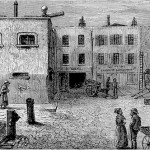Witches Walking Upside Down April 10, 2013
Author: Beach Combing | in : Modern
***By an act of all too characteristic incompetence this post was pre-published yesterday, some of you may then have missed the post before on four suicides (PS some great emails on that, just need some time to put up)*** How do witches fly? By broomstick, of course. Only consider this story, which appears in 1825 […]
British Witch Initiation c. 1970 April 3, 2013
Author: Beach Combing | in : Contemporary, Medieval
Witchcraft became a force to be reckoned with in Britain after the Second World War. There is a lot of writing, but most by the witches themselves (who can’t be trusted) or by CofE bishops who are just too silly for words because they take said witches seriously. Intelligent third-party descriptions like the following are […]
Bleeding-heart Yard and Nineteenth-century London Witches March 27, 2013
Author: Beach Combing | in : Modern
London legends rarely stretch back beyond the 1800s which is why this one, which is perhaps based on an Elizabethan legend, is such fun. The extract dates to 1841. Let any man walk into Cross-street, Hatton-Garden, and from thence into Bleeding-heart Yard, and learn the tales still told and believed of one house in that […]
Dogs of God! Christian Werewolves? March 21, 2013
Author: Beach Combing | in : Modern
This is one of those rare times in the early modern witch craze where one feels sorry for the judges. I mean they turn up at Jurgensburg in Livonia on the Baltic expecting an easy burning: old man widely thought to be a witch hauled up in front of them (though on another charge) and […]
The Last Witch in Dorset? March 20, 2013
Author: Beach Combing | in : Modern
This news story comes from the first quarter of the nineteenth century and from Bridport (Dorset, UK). It is a particularly vivid bit of witch-hunting from the south-west of the country at a date when these things were quickly vanishing into the past: though there would be another century of such attacks in rural Britain. […]
Fairy Witches #1: Joan Tyrry of Taunton March 15, 2013
Author: Beach Combing | in : Modern
Who was Joan Tyrry [Terry]? Beach knows very little, too little, in fact. And everything he does know about this sixteenth-century woman comes from Keith Thomas who in the 1960s visited Wells Diocesan Records and opened the dusty old boxes with A21 and A22 where her trial is recorded. KT never gave a detailed description […]
Review: Witches, Fantasies and Fairies March 8, 2013
Author: Beach Combing | in : Medieval, Modern
In 1966 Carlo Ginzburg, a WANW Italian historian, published I Benandanti. In this book, Ginzburg argued that a group of sixteenth-century Friulian peasants, who believed themselves to have super powers – they could fly and fight witches – were the last traces of a pre-Christian fertility cult in the region. Ginzburg went on to argue that […]
Wiccans and Fairy Shamans: Priority? January 23, 2013
Author: Beach Combing | in : Contemporary, Medieval, Modern
In the last thirty years there have been growing numbers of men and women who have expressed a belief in fairies: for a minority of these communion with fairies has come to take on the outlines of a of religious system. We even read of ‘fairy shamanism’ and special ‘congresses’ where believers experiment with contact […]
A German Vampire? December 6, 2012
Author: Beach Combing | in : Modern
A vampire in seventeenth-century Germany? Perhaps, perhaps not, but something strange was going on here. The year is 1685 and we are in Augsburg. George Schmetzer’s wife had just given birth and suffered back ache. While in the delicate state after child birth: the dreams began. She felt that someone was pressing down on her […]
Witches, Confessions and the Truth November 25, 2012
Author: Beach Combing | in : Medieval, Modern
Scholars of witchcraft in the burning years have an overwhelming problem. As rationalists they do not believe in the sabbat, devil sex or flying broomsticks. And yet, and yet… Women who were investigated often come up with the most extraordinary stories about the Satanic things that they have done. The problem for historians is why does […]
Crowds #6: Bully Crowds November 19, 2012
Author: Beach Combing | in : Contemporary
We have so far shown numerous posts on crowd photographs: crowd art, crowd speeches, August 1914 crowds, POWs in crowds and religious crowds. Here is by far the most unpleasant of the series – you have been warned! – bullying crowds. A group of people with power, perhaps newly acquired power, decides to revenge itself […]
Panty-stealing Zimbabwean Goblin August 16, 2012
Author: Beach Combing | in : Actualite
This news story ran at the end of July. Why, on earth, didn’t it receive more international attention? Perhaps the world was tired of Zimbabwean mermaids. The version here comes (cut) from the The Herald (Zimbabwe). A sixty-two year-old Gokwe man has come out in the open and claimed ownership of a goblin which has […]
Sixteenth-century Conjuring Tricks June 30, 2012
Author: Beach Combing | in : Modern
It was a slow day in the cave, the sabre-tooth tigers were roaring outside and the grass shoots and snails had all been consumed. Ug was playing with the knuckle bones of one of his late wives and with remarkable dexterity (given how poor he had been at hunting recently) he made the bones dance […]
All Hail the Male Witch! June 21, 2012
Author: Beach Combing | in : Medieval, Modern
Why were witches, in the early modern period, women? The simple answer is that they were not. In all parts of Europe there were male witches and in some part of Europe male witches (witch = those put on trial for that crime) outnumbered narrowly or substantially the number of female witches. So at one […]
Shape-Shifting in a Nineteenth-Century Court-Room May 18, 2012
Author: Beach Combing | in : Modern
Beachcombing has visited the Isle of Man on several occasions in this blog (he has only been once physically): there was the mermaid sighting from an early submarine, the drunk Manx buggan, and the early medieval kingdom of Mannau. But he is confident that this story will trump them all. Our author has been describing […]


